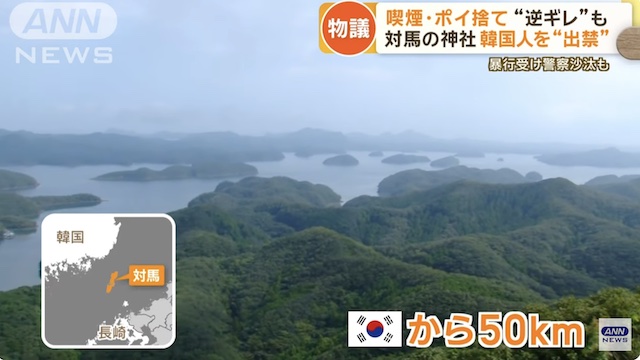NAGASAKI, Jun 08 (News On Japan) - A shrine in Tsushima, Nagasaki Prefecture, with over a thousand years of history, has controversially banned Korean tourists. This decision has sparked widespread discussion.

Watatsumi Shrine, located in Tsushima, Nagasaki, is a historic site known for its picturesque, oceanic torii gate. The shrine is a mere 50 kilometers from Korea, making it a popular destination for Korean tourists who can reach it in approximately an hour and a half by high-speed ferry.
Recently, issues have arisen at the shrine. Several Korean tourists have been seen smoking within the shrine's grounds, an act prohibited by local ordinances, and disposing of cigarette butts carelessly.
Confrontations have occurred when other visitors attempted to intervene, sometimes leading to verbal abuse.
A Korean male tourist remarked: "What are you fussing about?"
Cigarette butts are frequently discarded throughout the shrine and its surroundings, with shrine officials noting that eight out of ten Korean tourists engage in such nuisances.
Past incidents of misconduct by Korean tourists have escalated to violence against shrine personnel, resulting in police involvement.
'No Plans to Lift the Ban'
In response to these acts, the shrine took a decisive step by posting signs at the entrance stating, "Korean tourists are prohibited from entering," written in Korean.
When asked about this decision, Watatsumi Shrine officials explained: "As a small shrine, it is challenging to host a large number of Korean visitors and control disrespectful behaviors. We have no intention of lifting the ban on Korean visitors anytime soon. As custodians of this sacred site, we are committed to maintaining our stance and protecting this place."
This measure has led to mixed reactions among the local community.
A Korean tourist stated: "We should respect the culture of the country we visit, so it's regrettable that some of us failed to do so. This incident should serve as a wake-up call for all tourists to act more prudently."
A local resident in their 60s commented: "Perhaps a misunderstanding due to unfamiliarity on both sides. Maybe an additional buffer could have been helpful. It's disappointing to hear about the ban. It shouldn't have come to this."
A younger local in their 20s added: "Not all Korean people behave this way; it's just a few who did, so while the ban is understandable, it might be lifted eventually."
A Difficult Decision Elsewhere
Similar issues have arisen at other locations. Foreign tourists have been seen roughly handling the bell ropes at shrines.
A man who posted a video online said: "I asked them to stop. They didn't look happy about that. I hope visitors to Japan understand and respect Japanese etiquette."
Source: ANN















